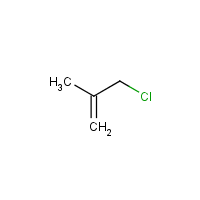3-Chloro-2-methyl-1-propene
Agent Name
3-Chloro-2-methyl-1-propene
Alternative Name
Methallyl chloride
CAS Number
563-47-3
Formula
C4-H7-Cl
Major Category
Other Classes

Synonyms
Methallyl chloride; 3-Chloro-2-methylprop-1-ene; 3-Chloro-2-methylpropene; 1-Chloro-2-methyl-2-propene; 2-Methallyl chloride; 2-Methyl-2-propenyl chloride; 2-Methyl-allylchlorid [German]; 2-Methylallyl chloride; 3-Chlor-2-methyl-prop-1-en [German]; 3-Chloro-2-Methylpropene; 3-Chloro-2-methylpropene (IUPAC); 3-Chloroisobutylene; 3-Cloro-2-metil-prop-1-ene [Italian]; Chlorue de methallyle [French]; Chlorure de methallyle [French]; Cloruro di metallile [Italian]; Isobutenyl chloride; MAC; Methallyl chloride; Propene, 3-chloro-2-methyl-; beta-Methylallyl chloride; gamma-Chloroisobutylene; [ChemIDplus] UN2554
Category
Halogenated Aliphatics, Unsaturated
Description
Colorless to yellow liquid, with pungent odor; [ICSC] Odor: stench; [MSDSonline]
Sources/Uses
Used to make insecticides, plastics, pharmaceuticals, and other chemicals; Also used as a fumigant for grains, tobacco, and soil; [Hawley]
Comments
A skin, eye, and respiratory tract irritant; Tear drawing; Inhalation of high concentrations may cause CNS effects; May cause skin sensitization; [ICSC] Dangerous fire risk; Explosive limits in air are 3.2 - 8.1%; [Hawley] Harmful by inhalation and ingestion; Causes burns; Lachrymatory effect; May cause skin sensitization; [MSDSonline] See "Carcinogenicity of some industrial chemicals," Volume 115. [IARC, News Release, 23 February 2016] Methylallyl chloride (UN2554) has warning of explosive polymerization; [ERG 2016]
Biomedical References
Exposure Assessment
Vapor Pressure
102 mm Hg
Lethal Concentration
LC50 (rat) = 34,000 mg/m3/30 min
Explosive Polymerization
Yes
Explanatory Notes
Flash point = -12 deg C; [HSDB] VP from ChemIDplus;
NFPA
may ignite at ambient temp
Adverse Effects
Skin Sensitizer
Yes
Lachrymator
Yes
Neurotoxin
Acute solvent syndrome
Hepatotoxin
Hepatoxic (a) from occupational exposure (secondary effect) or (b) in animal studies or in humans after ingestion
Dermatotoxin
Skin burns
IARC Carcinogen
Possible (2b)
NTP Carcinogen
Anticipated human carcinogen
Diseases, Processes, and Activities Linked to This Agent
Diseases
Occupational diseases associated with exposure to this agent:
Processes
Industrial Processes with risk of exposure: